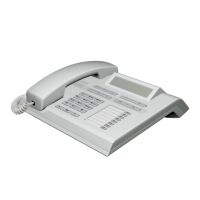Functions used when receiving calls
81
Step by step
Groups
1
A group consists of extensions linked by type or prox-
imity. Its goal is to prevent calls from going unanswered
when an extension is busy or absent.
Call groups (CG)
When a call to a Call group (CG) is received, it rings at
all the extensions for that group. The first user (tele-
phone) to answer the call initiates conversation with the
caller. The other telephones stop ringing when the call
is answered.
Calling a Call group (CG)
j Enter the Call group number.
• 770 to 779
= Call group (CG);
w [ Wait for the call to be answered. Start conversation.
Hunt groups (HG)
2
The Hunt group (HG) feature allows you to configure ex-
tension groups which are then assigned for answering
calls directed to a specific number (up to 10 Hunt
groups, from 780 to 789).
When a group receives an incoming call, the call rings
at one extension at a time. If an internal or external call
is not answered after a specified timeout, it rings at the
next extension, and so on, until it is answered by an
available extension. The selection of an extension
where unanswered calls should ring is made in two dif-
ferent ways: linear or round-robin.
• A linear search always starts from the first extension
in the group.
• A round-robin search starts after the last extension
selected.
[1] See Programming an extension - groups, in the Programming man-
ual.
[2] See Programming an extension - Hunt groups (HG) - Search mode
for Hunt groups, in the programming manual).

